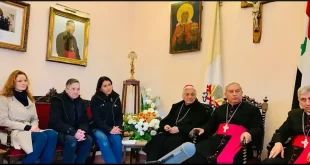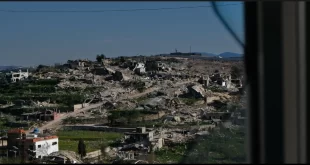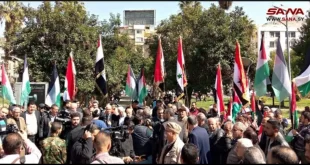October 9, 2017 Antiwar.com – Gareth Porter
Eliot Higgins is a “nonresident senior fellow” with the Atlantic Council whose functions appear to include seeking to discredit any reporting or analysis and documentation that conflicts with the DC-based think tank’s interventionist agenda. Higgins’ agenda dovetails closely with his employer’s funders in NATO as well as Atlantic Council backers like Saudi Arabia, Qatar and Turkey – the states that have also bankrolled Syrian Salafi insurgents.
Higgins flew into an online rage as soon as I published my article at AlterNeton the allegations of a sarin attack in Khan Sheikhoun. Although the article shows that a conventional airstrike in Khan Sheikhoun did cause large numbers of dead and injured, I also exposed evidence of a deception mounted by al Qaeda’s local Syrian affiliate to convince the world that the regime had carried out a sarin attack from the air in Khan Sheikhoun. These revelations were anathema to Higgins, who supports the official U.S.-NATO version of events against any critical examination, and to an almost religious degree.
Higgins launched an all-out attack on the article consisting of dozens of tweets, none of which has actually challenged the evidence presented in the article. In his initial volley, he sought to portray my use of the term “building” for a two-story structure connected to the others but clearly distinct from them as a serious prevarication.
On the other hand, Higgins betrayed no pang of conscience over defending a position that is clearly at odds with the facts. When I asked Higgins in a tweet how he explained the complete absence of the pieces of a weapon that should have been found near the crater, he responded as though he had no need for any explanation: “I prefer not to speculate.”
The brunt of Higgins’s attack was aimed at my detailed case that the Organization for the Prohibition of Chemical Weapons (OPCW) based its overall conclusion of a government sarin attack on test results of biomedical and environmental samples that either could have been manipulated – or that OPCW simply failed to consider an alternative explanation that was consistent with the actual results.
Higgins did not contest any of the points that I documented, including the fact that two scientists with ties to OPCW acknowledged in e-mails that the OPCW test for IMPA – the main breakdown product of sarin in the body – could produce a false positive. All that al Qaeda’s local operatives would need to do fool the OPCW test would be to administer the subject giving a biomedical sample a dose of IMPA, a harmless compound sold by major chemical companies.
At the same time, Higgins claimed to be scandalized that I would dare to assert that al Qaeda’s Syrian franchise authorities could have planted sarin in the environmental samples and fooled the OPCW’s test for IMPA in biomedical samples.
Higgins demanded to know from whom al Qaeda obtained the sarin. He did not make the same demand in regard to the IMPA, the availability of which can be easily documented.
The real issue is not whether we know from whom, where and when Nusra Front officials obtained sarin, but whether the OPCW test results represent incontrovertible evidence, as Higgins insists. OPCW itself has in the past taken the formal position that they do not and cannot rely on samples that could have been tampered with. As I documented in my report, the OPCW itself adopted a rule in 2013 that neither biomedical or environmental samples could be used as evidence for any conclusion about the use of chemical weapons unless the organization had a complete, reliable chain of custody for the samples – meaning that that the OPCW staff would have to be directly involved in the collection of the samples.
But in the case of Khan Sheikhoun, the OPCW collected no environmental or biomedical samples in Khan Sheikhoun, because it never set foot in the city. Instead it accepted environmental samples collected by the White Helmets – a civilian and de facto media arm of the Al Qaeda-tied rulers of Idlib – along with biomedical samples collected by the Idlib Health Directorate and a private pro-rebel Syrian-American organization that operates field hospitals in Idlib. The OPCW then reported on the positive results for sarin as evidence in support of its conclusion that a sarin attack had caused the deaths and injuries. In doing so, the OPCW massively and shamefully violated its most fundamental protocols, and nullified the validity of its conclusion.
Higgins’s Twitter rant asserted also that the sarin in question could definitely be linked to the Syrian government. In two paired tweets, he wrote, “The Sarin was found with hexamine and other byproducts… This matches with other samples which would link it to the Syrian government’s Sarin.”
But his argument is false and misleading. It is, in fact, based on a French“National Evaluation” published on April 27 that was clearly aimed at making a political splash at the expense of the truth. The French government determined that the sarin in the environmental samples it obtained from Khan Sheikhoun had the same elements as those that it obtained from the site of an apparent chemical attack in Saraqeb in northern Idlib province in April 2013. According to that same French document, the French government had concluded from the sarin found in an unexploded grenade that the Syrian government had manufactured sarin by a process that utilized hexamine. On the basis of that conclusion, the French government insisted that the Syrian government must have carried out sarin attacks in both Saraqeb and Khan Sheikhoun.
In fact, however, the evidence of a government sarin attack in Saraqeb was highly questionable. Videos and photographs taken at the site of the attack in Saraqeb showed a tiny white polymer canister with a fly-off handle and four holes distributed evenly around its surface, each of which had marks around them. A chemical weapons specialists who examined the photos and videos noted that it did not appear to have delivered sarin, which would not have left such marks around the holes. Higgins should remember that testimony, because it was Higgins who interviewed the specialists for his “Brown Moses” blog.
A little more than three weeks before the attack, photographer Jeff Ruigendijk had photographed an al-Nusra Front cadre with that same white canister hanging from his jacket. After the attack, Die Welt correspondent Alfred Hackensberger interviewed Nusra Front fighters in the Aleppo area who showed him similar canisters in their equipment and described them as smoke grenades that had been captured from government depots.
Those canisters were the only ones filmed or photographed in the immediate aftermath of both the alleged sarin attacks in Saraqeb and Sheikh Maqsoud. Only four years later did the French government publicize details of the unexploded grenade said to have been found in Sarqeb that contained sarin announced its analysis of its constituent elements. Yet even through the governments of France and United Kingdom brought the incident to the attention of the U.N. mission, the mission’s report notes it was “not able to collect any primary information on munitions” – meaning that it was not given access to the grenade holding sarin.
And the grenade is not shown in the photographs and videos of the spot where the French paper said it was found. These facts suggest that the grenade was introduced by local officials in Idlib only later. Contrary to Higgins and the French government, therefore, it does not constitute proof that a sarin-filled bomb was dropped on Saraqeb by Syrian government. The sarin in the environmental samples from Khan Sheikhoun may indeed be from the same source as the sarin found in the grenade obtained by the French government, but it doesn’t prove that it was deployed from Syrian government weapons.
Higgins has argued that the presence of hexamine in the sarin incriminates the government, because the government turned over supplies of hexamine under the 2013 agreement that prompted it to give up its entire stock of chemical weapons. But Ake Sellstrom, the head of the U.N Mission that investigated the Saraqeb and other cases from 2013, doesn’t agree. Sellstrom wrote to MIT Professor Theodore Postol on June 18, 2014 that hexamine is “a product simple to get hold of and in no way conclusively points to the government.”
Higgins’s aggressive tweetstorm betrayed a weak hand. Desperate to defend the narrative he is employed to enforce, he let loose a heavy barrage of smoke but proved that he doesn’t have the facts to support his attack.
 Syria Support Movement solidarity with the Syrian people
Syria Support Movement solidarity with the Syrian people




